Most patients admitted to a hospital require a vascular access device (VAD) during their hospitalization (Helm et al., 2015; Keleekai et al., 2016; Plohal, 2021). This common procedure is often performed by nurses trained to place peripheral intravenous catheters (PIVCs) using traditional landmark techniques. Between 8%–23% of the population are referred to as having difficult intravenous access (DIVA) and present challenges due to a lack of adequate peripheral veins, often requiring multiple attempts to successfully place a VAD (Armenteros-Yeguas, 2017; Davis et al, 2021). Repeated venipunctures cause pain and anxiety for patients, decrease satisfaction with care, and increase costs for supplies and clinician time. With each unsuccessful attempt, availability of peripheral veins appropriate for PIVC insertion diminishes, which increases the likelihood of escalation to a central venous access device (CVAD) as a rescue access and poor patient outcomes (Adkihari et al, 2015; Au et al, 2012; Paje et al, 2018; Psaila et al, 2023).
Central venous access devices are associated with increased risk to patients, such as central line-associated bloodstream infections (CLABSIs), thrombosis, and pneumothorax, each known to increase hospital length of stay and associated costs (Buetti et al, 2022; Chopra et al, 2014; Shokoohi et al, 2013). All ADs, not just CVADs, present an infection risk (Buetti, et al, 2022). Bloodstream infections are often caused by contamination during insertion or manipulation of the catheter hub whereby bacteria migrate down the catheter, or by seeding of the catheter from secondary contamination from bacteria in the bloodstream. The majority of PIVC-related bloodstream infections come from normal skin flora on the patient or clinician (Choudhury et al, 2019; Zhang et al, 2016). Bloodstream infections have a mortality rate between 12%–25%, increasing hospital length of stay, and, subsequently, cost of patient care (Gahlot et al, 2014; Schechner et al, 2022). These risks can be reduced by implementing best practices in VAD placement, care, and maintenance, limiting the number of attempts to place through early identification of DIVA patients, and 24/7 availability of nurses trained to insert ultrasound-guided peripheral intravenous catheters (USGPIVC) (Shokoohi et al, 2013).
Training nurses to place USGPIVCs is becoming more prevalent throughout the US as the use of vascular access specialists is recognized as best practice (Bell and Spencer, 2021; Gorski, 2021; Miles et al, 2012; Amick et al, 2022). Additionally, timely VAD placement has been shown to increase throughput in overcrowded emergency departments (EDs) and expedites completion of diagnostic studies and patient treatment (Au et al, 2012; Adhikari et al, 2015). This is an account of how one organization developed a vascular access excellence (VAE) initiative to improve the care of all patients requiring vascular access.
Methods
To improve first-attempt success, preserve vessel health, and reduce complications, a new approach to vascular access was deemed necessary. In 2016, a 263-bed public district hospital in California had the opportunity to trial a guidewire-assisted PIVC (AccuCath AceTM by Becton Dickinson and Company, Franklin Lakes, NJ) designed to navigate tortuous vessels and able to be inserted with ultrasound. At the time, the hospital had three nurses working in the Diagnostic Imaging (DI) Department trained to place peripherally inserted central catheters (PICCs). They were often called upon to place difficult PIVCs, but were scheduled only Monday–Friday between 0700 and 1830. The critical care educator saw an opportunity to improve patient care and proposed trialing the PIVC and development of an ultrasound-guided (USG) insertion training program. Recognizing the benefit of training frontline nurses to place USGPIVCs, the proposal was enthusiastically embraced, and the first cohort of nurses was selected to evaluate the new program (Campos et al, 2020).
Ultrasound-guided peripheral intravenous catheter insertion training
In collaboration with an industry vendor, the critical care educator set up the initial USGPIVC training course with six nurses; three each from the ED and DI. Nurses completed an online training module followed by a 5-hour didactic course with a review of peripheral veins, anatomy, appropriate vessel selection, and ultrasound basics. Following the classroom training, each nurse participated in two 4-hour proctored sessions, in which they placed USGPIVCs in the clinical environment under the direct supervision of the clinical educator. The nurses were required to successfully insert a minimum of three USGPIVCs to be validated as safe to perform independent insertions (Campos et al, 2020).
All six nurses successfully completed the training and provided feedback through a satisfaction survey. The survey results were positive and the group recommended moving forward to use the PIVCs hospital-wide. Through a series of presentations at Value Analysis and other required committees, approval was received in July of 2016 to formally purchase the PIVCs and begin facilitating additional training sessions.
In 2017, a DNP Capstone project designed to improve patient outcomes from nurse-placed VADs was reviewed by the Institutional Review Board (IRB) and deemed performance improvement, not research. Approval was received from the Medical-Surgical Director to carry out the project in the four medical-surgical units of the hospital (Campos, 2019). The project included the implementation of an evidence-based nurse-driven protocol, developed by the critical care educator, for the early identification of DIVA patients that included direction for successful VAD placement (Figure 1).
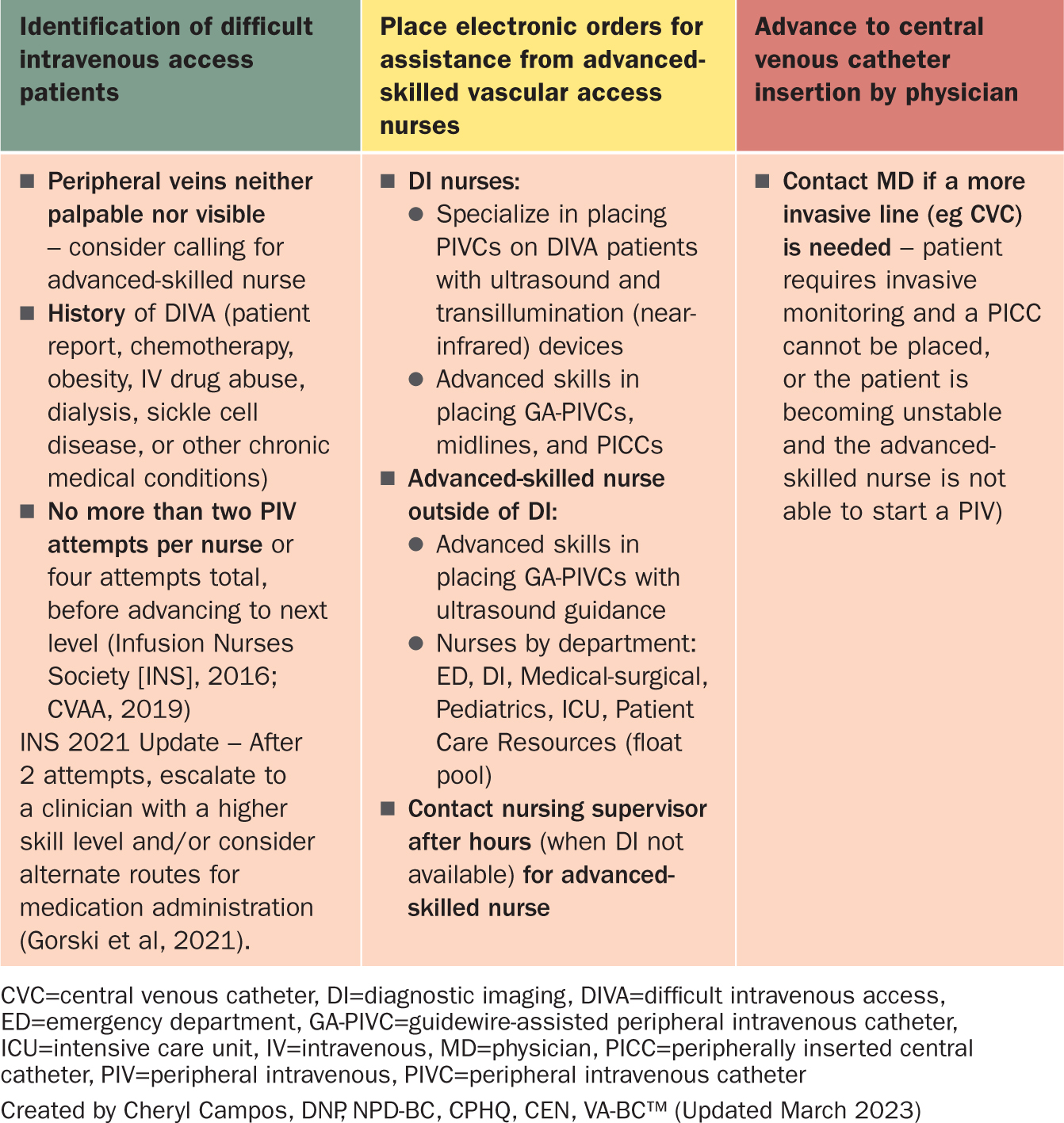
To capture metrics for the performance improvement project, such as number of attempts, type of device placed, use of ultrasound, dwell time, and complications, the critical care educator worked with the Manager of Clinical Informatics to modify documentation in the electronic medical record (EMR). In addition, a report was created by the Senior Analyst to abstract patient- and clinician-specific data. Education was provided to nurses throughout the hospital on the new fields available in the EMR, peripheral vascular access device (PVAD) site assessment options, and the importance of accurate documentation.
The nurses trained to insert PICCs and USGPIVCs played a pivotal role in the DNP project, as they were the advanced skilled nurses called upon when nurses identified DIVA patients. When a PICC was requested, the DI nurses referred to an evidence-based VAD selection algorithm, by Simonov et al (2015), to choose the most appropriate VAD for the patient, thereby preventing inappropriate PICC placements (Campos, 2019). Prior to implementation, education was provided to medical-surgical unit staff who were participating in the DNP project, marking the beginning of formalized training for nurses to change their practice and management of DIVA patients.
Following completion of the DNP Capstone project, USGPIVC insertion training continued using the original model to sustain a consistent level of care throughout the hospital. Additional training was offered by the clinical educators each time a new cohort of nurses was trained, as a strategy to refresh and maintain competency in USGPIVC insertion.
Vascular access committee
As the training and experience of the DI nurses developed and evolved, additional staff training and a more structured approach were needed to fulfil the requests for VAD placement on DIVA patients. Managing telephone requests and jotting notes on a whiteboard and paper log were proving inefficient and difficult to track. In late 2018, a Vascular Access Committee was formed under the Shared Governance Quality Council. This committee included representation from the Chief Nursing Officer (CNO); nursing leaders from ED, DI, and Education; DI nurses; and Materials Management.
To address workflow concerns, the DI Charge Nurse created a presentation for the committee that outlined best practices, current literature, and three potential solutions to manage the requests for VAD placement: (1) creating a formal vascular access team, (2) expanding the DI nursing staff to include an additional registered nurse (RN) for PVAD and PICC placements, and (3) more USGPIVC-trained nurses throughout the hospital. The Committee chose option three, placing priority on increasing the number of generalist nurses trained as advanced-skilled nurses on the night shift to provide 24-hour coverage. To support the process, an additional ultrasound machine was purchased and housed in the nursing supervisor's office to ensure easy access.
Vascular access device referral
The committee also developed a new electronic nurse driven order that allows nurses to request assistance with PVAD placement in DIVA patients. The PVAD referral was created in the electronic medical record (EMR) to convert the process from telephone referrals, originally trialed during the DNP Capstone project in 2017, to an electronic process. Once submitted, referrals print directly to DI during business hours and the nursing supervisor's office after hours. The nurse submitting the referral is required to complete a vein assessment (good, poor, none), pertinent patient history (eg renal disease or breast cancer), and the reason for vascular access (Figure 2). The referral process was effectively streamlined, making prioritization and utilization of resources easier to deploy and track.
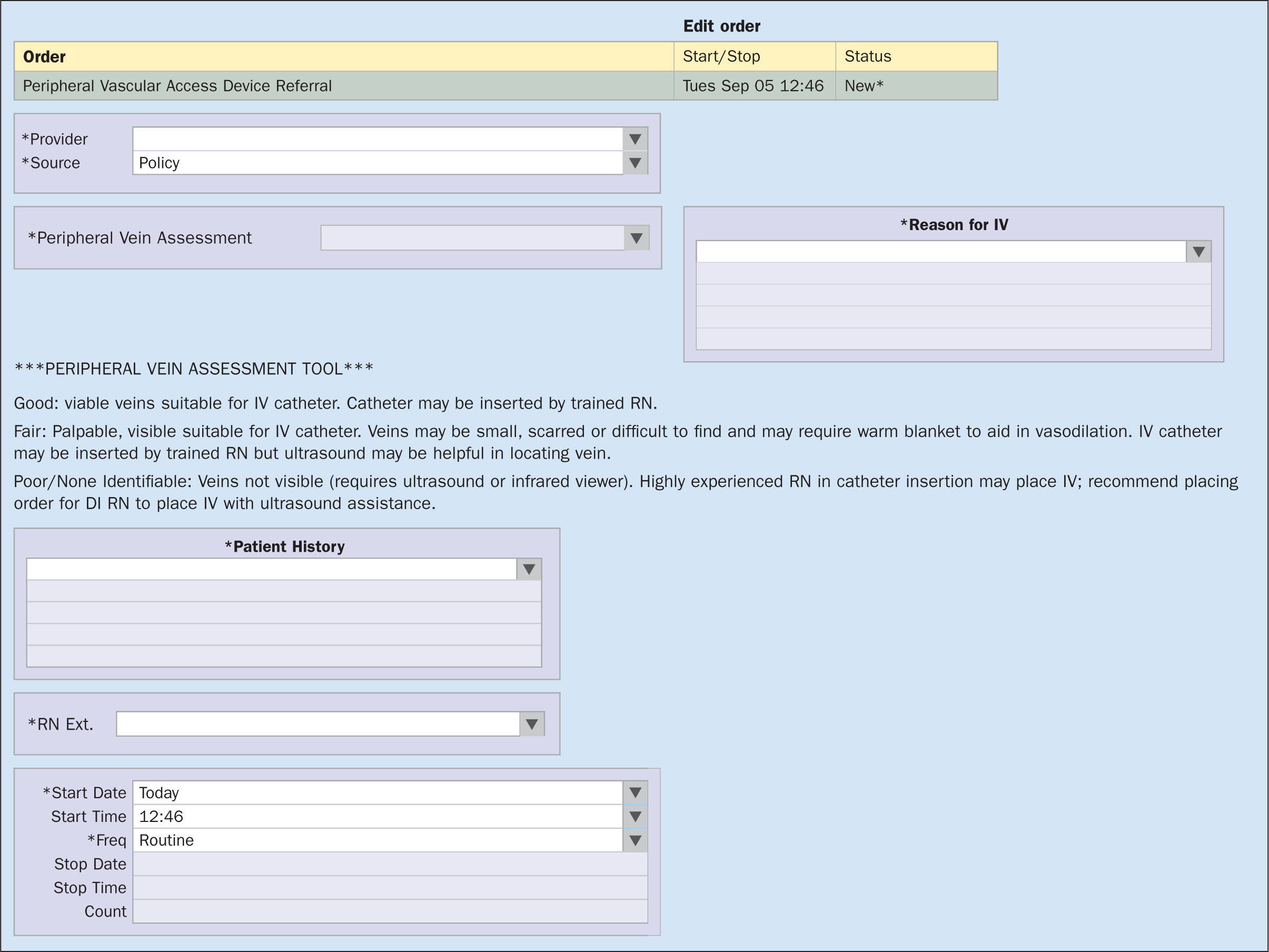
Hospital-wide nursing engagement and education initiative
Efforts to reduce VAD-related infections gained momentum when the hospital started the nursing Magnet journey in 2017–2018. The journey created engagement and empowerment of the nurses to design processes to improve patient care and outcomes. The nursing staff, with support from infection prevention and clinical leaders, conducted product trials, reviewed central line best practices, and created a comprehensive CVAD insertion and maintenance bundle to address the increase in CLABSIs seen in 2019.
In the fall of 2019, members of the Vascular Access Committee participated in a hospital-wide nurse education initiative that focused on VAD insertion, care, maintenance, and formal implementation of a CVAD insertion and maintenance bundle. Further education was provided to reinforce the importance of vein assessment and early identification of DIVA patients for appropriate escalation to an advanced-skilled nurse. This included guidance in the use of the electronic PVAD referral that went live in December 2019. Nurses were also in-serviced in the use of near-infrared devices for vein visualization, of which there were three throughout the hospital.
Vascular access assessment
After the COVID-19 pandemic, the Vascular Access Committee regained focus in 2021 and sought approval to be called the Vascular Access Excellence Committee (VAEC). The VAEC was established as a multidisciplinary committee led by bedside nurses as the acting chair and co-chair and the Medical-Surgical Director as the executive nursing sponsor. Members include stakeholders from nursing, pharmacy, infection control, education, clinical informatics, DI, ED, employee health, materials management, quality management, and an Infectious Disease Physician Advisor. The committee acts as an oversight council to review all issues related to vascular access, such as products, education, and infection control data. With CNO approval, the hospital collaborated with an industry partner to conduct a vascular access assessment of the current practice within the hospital in May 2022. The assessment was conducted over the course of several days and consisted of evaluating products available on each unit, VAD insertion and medication administration techniques, nurse perceptions, and documentation in the EMR. A comprehensive assessment was created and findings were presented to the VAEC and the CNO.
Peripheral intravenous catheter champion training
The vascular access assessment provided a baseline of current vascular access practices and led to additional efforts to drive vascular access excellence (VAE) throughout the organization. In March and April of 2023, the organization's commitment was demonstrated further by prioritizing training of bedside nurses and providing tools needed to support their success in vascular access placement. The organization purchased five more near-infrared vein visualization devices, upgraded one bedside ultrasound machine for use in the Outpatient Infusion Center, and purchased a new ultrasound machine for the ED.
In early 2023, it was identified that bedside nurses wanted additional support to retain their PIVC insertion skills. Maintenance of those skills was challenging due to a variety of factors, including less frequent practice and a high prevalence of hospitalized DIVA patients. The organization partnered with an external vascular access education company to train a group of unit-specific nurse Champions in basic PIVC placement. The 8-hour training was offered twice and included didactic and hands-on PIVC insertion skills sessions. Fifty nurses attended, representing each unit of the hospital and all shifts. As a support strategy, the clinical nurse educators also attended the PIVC Champion training courses.
Champions' commitment, expectations, and desirable qualities include dedication to VAE and program success, full-time employment allowing them to be available as a resource on the unit, and respect by their peers. The PIVC Champions are expected to precept and train new nurses, uphold the standards in the department, and help communicate updates to PIVC training, documentation, and new standards as evidence becomes available. Accordingly, new VAD training arms and hands were purchased to update the supplies available in the Education Department.
Results
Ultrasound-guided peripheral intravenous catheter insertion training
Having recognized the value of advanced-skilled nurses, requests for USGPIVCs drastically increased throughout the hospital. Additionally, requests for the ED physicians to insert CVADs occurred less often, allowing the physicians to complete other workload activities. Difficult intravascular access patients began requesting USGPIVCs once they experienced the benefit of ultrasound guidance. Between July 2016 and September 2017, 32 nurses throughout the hospital successfully completed the training with representation on all shifts and from multiple units, including the ED, DI, intensive care unit (ICU), Medical-Surgical, and Patient Care Resources (float pool).
The clinically relevant outcomes of the DNP Capstone project demonstrated higher first-attempt success rates with USGPIVC versus standard PIVCs (1.5 versus 1.7 attempts) and longer dwell times (3.87 versus 2.01 days), resulting in fewer VADs used to complete IV therapy (from 4 to 1 for an average hospital stay of 4.6 days). The process also demonstrated a shorter time from a call for advanced-skilled nurse assistance to successful device placement (1.41 versus 1.66 hours) or a decrease of 15 minutes to get a nurse to the bedside (Campos, 2019). These findings are consistent with other studies evaluating USGPIVC insertion programs (Adhikari et al, 2015; Bahl et al, 2018; Amick et al, 2022; Dhanani et al, 2022).
As of 2022, a total of 76 nurses had completed the USGPIVC training. To begin to capture data more effectively, the Manager of Clinical Informatics developed reports from the EMR to provide a clearer clinical perspective on vascular access device insertion, care, and maintenance. The reports revealed that despite staff turnover since the initial course taught in 2016, 40 nurses were still actively inserting USGPIVCs. By March 2023, 92 nurses completed the training, one in 10 nurses, hospital-wide, and nearly half of the ED nurses. Figure 3 shows a snapshot of USGPIVC placements in January 2023 categorized by shift inserted. Notably, 44% of the USGPIVCs were placed by night-shift nurses, and the majority were placed by the night-shift supervisor.
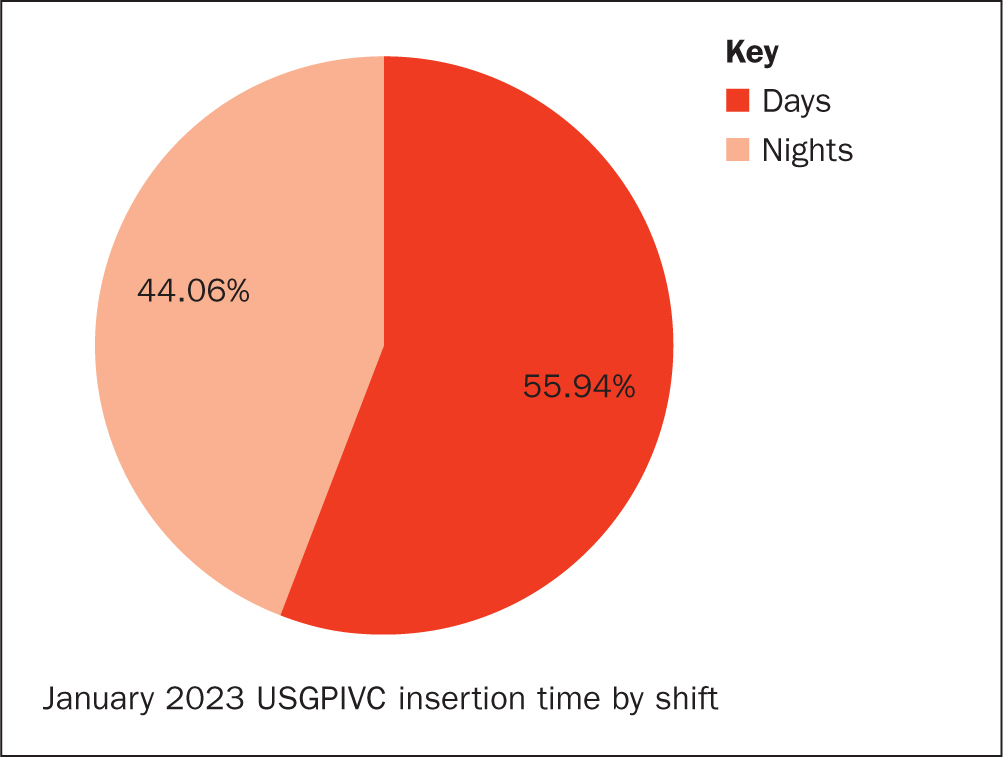
In the first quarter of 2023, 2,950 patients were admitted to the hospital. A total of 5,610 PVADs were placed. Approximately 495 (8.8%) were USGPIVCs. Of the 495 USGPIVCs placed, 108 (22%) were placed by DI nurses, 193 (39%) were placed by ED nurses, and 94 (39%) were placed by nurses working on the inpatient units (see Figure 4).
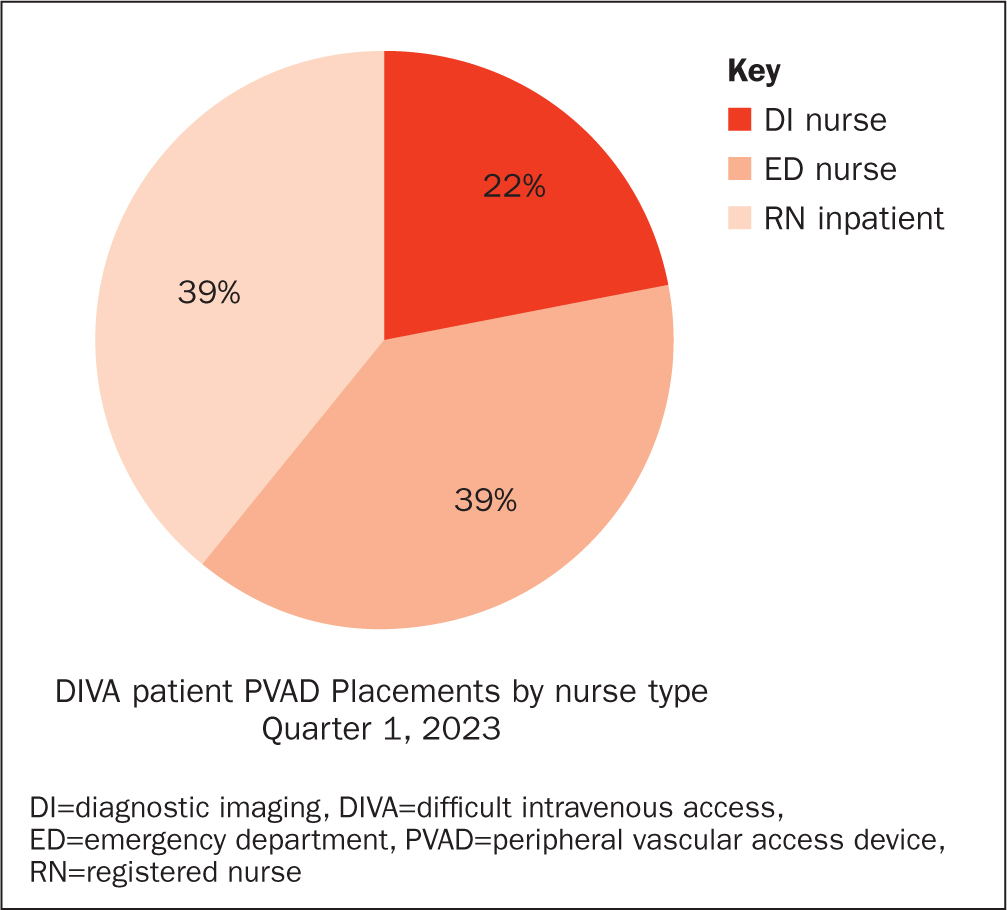
Because access to vein-visualization equipment is imperative for the VAE program's success, the hospital currently maintains a total of seven ultrasound machines that can be used for VAD insertion: two in ED, three in DI, one in ICU, and one stored in the nursing supervisor's office for in-hospital staff use. At present, there are also 11 near infrared vein visualization devices located in various units throughout the hospital.
Vascular access device referral
The number of VAD referrals submitted between November 2019 and February 2023 is displayed in Figure 5. A steady increase in requests was seen over time, doubling since 2019. The number of referrals placed closely aligns with the actual number of USGPIVCs placed.
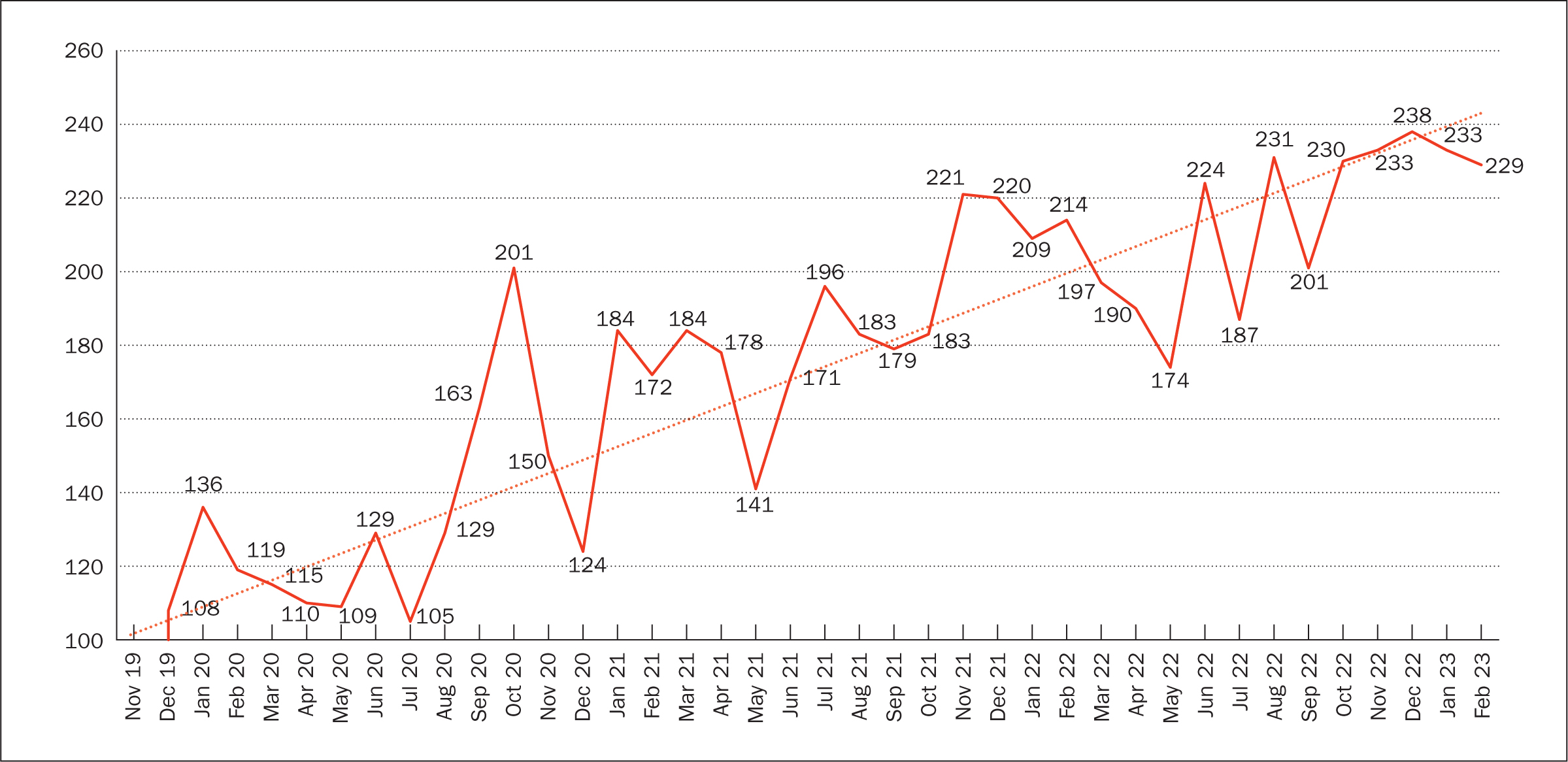
Central venous access device insertion and maintenance bundle
The number of CLABSIs went from four in 2019 to one in 2020 following the bundle education and implementation, demonstrating the infection prevention efforts' effectiveness.
In addition, there was a significant and sustained reduction in central line (CL) utilization, from the time use-tracking began in 2018, as seen in the downward trend in Figure 6.
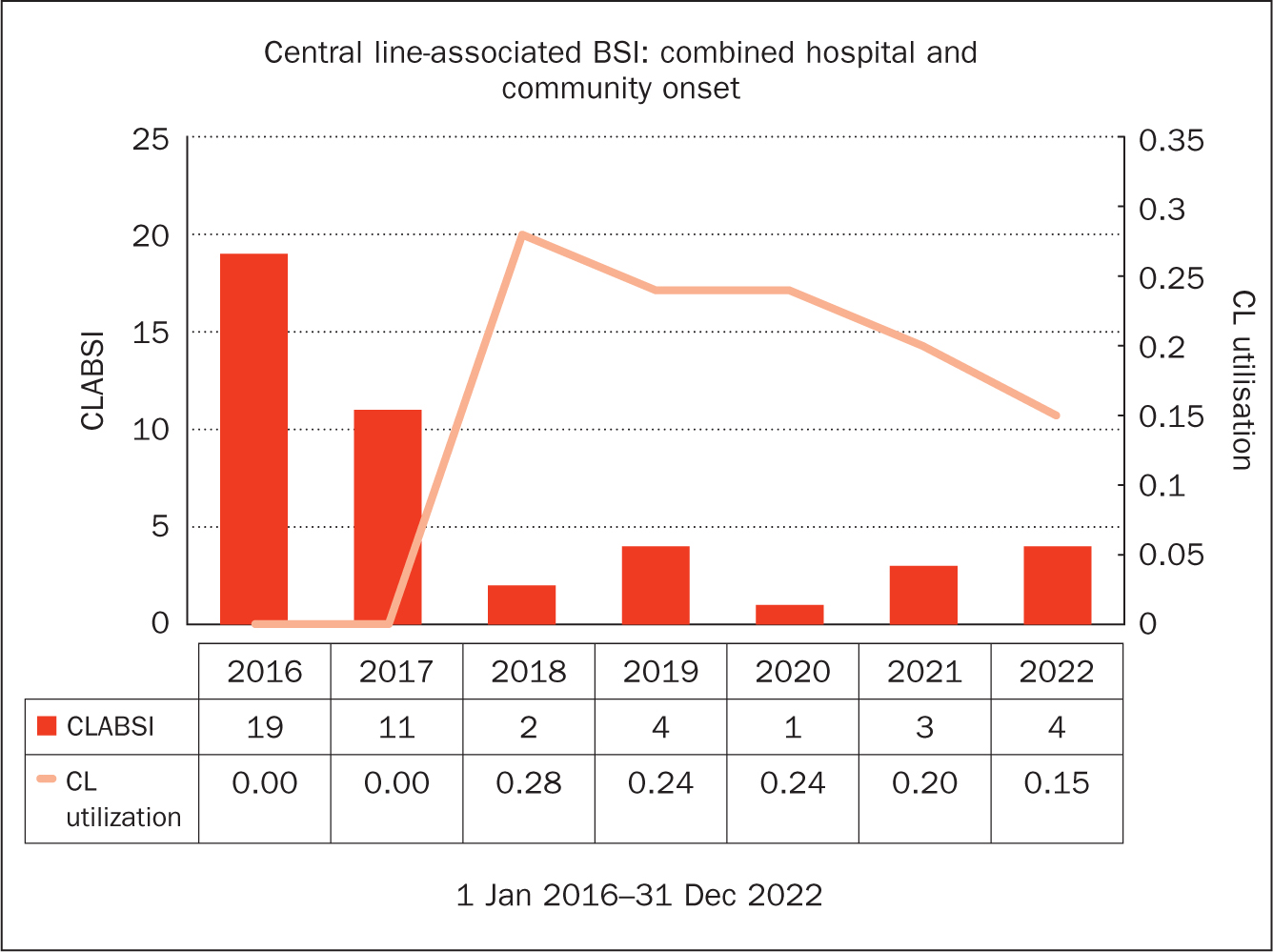
Though mandates are not yet in place requiring hospitals to publicly report all bloodstream infections, regardless of cause, the infection prevention nurse has been tracking these since 2016. Figure 7 shows the trend in PIVC infections through 2022. Following hospital-wide nursing education on insertion, care, and maintenance of CVADs in the Fall of 2019, a positive impact was seen by the reduction of non-central line-associated BSIs, going from six in 2019 down to one in 2020.
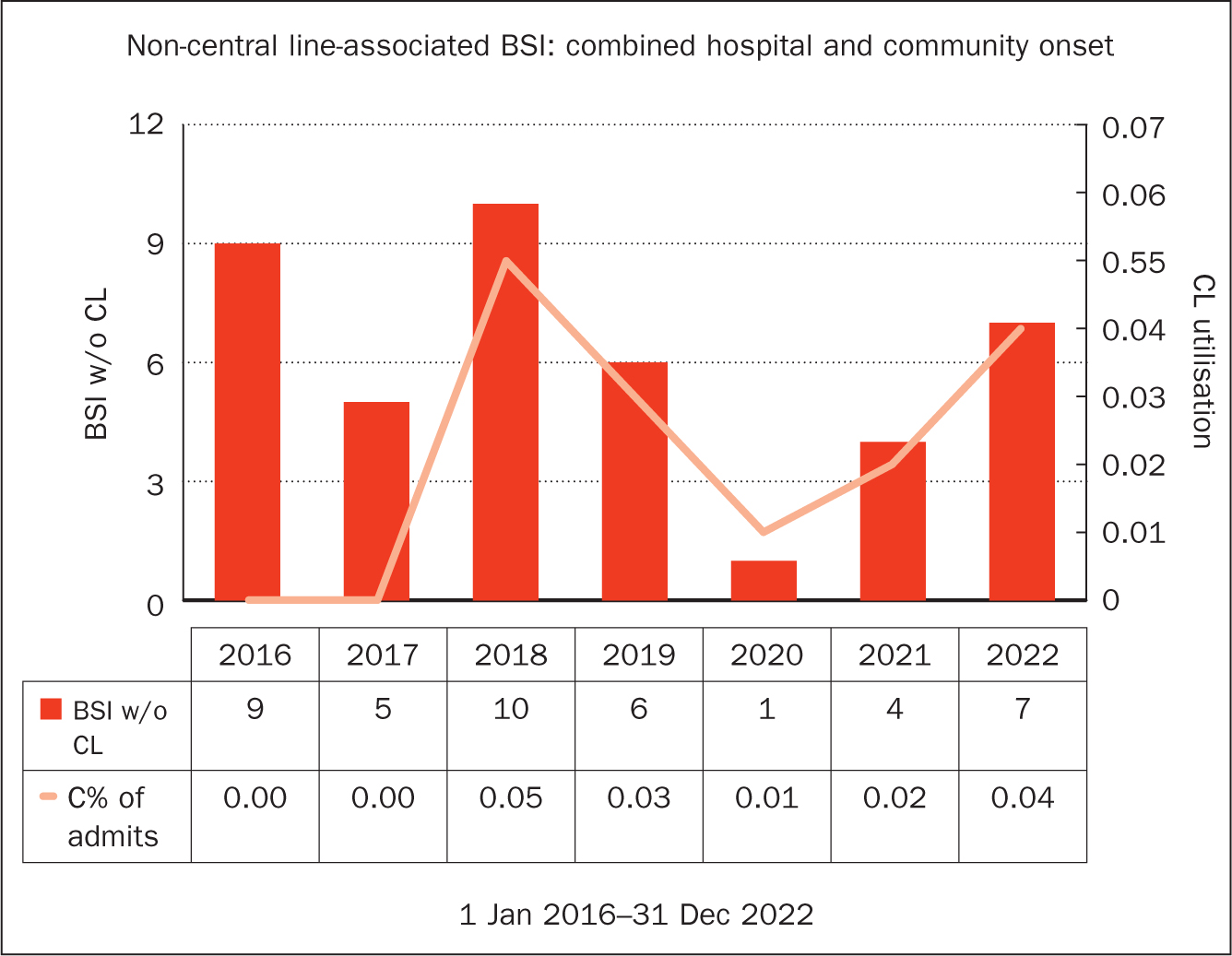
Vascular access assessment
The vascular access assessment conducted in May 2022 revealed a need for standardization of VAD-related products and provided recommendations to incorporate the 2021 Infusion Nursing Standards of Practice into hospital policies. As a testimony to the ongoing support for VAE, the vascular access assessment revealed nurses were able to get an advanced-skilled vascular access nurse to the bedside in under an hour 73% of the time. Twenty-seven percent of the nurses reported they were trained in USGPIVC insertion and had access to an ultrasound device 100% of the time (Salinas Valley Memorial Hospital, 2022).
Peripheral intravenous catheter champion training
Nurse Confidence Assessments were performed at the beginning and completion of the PIVC Champion courses taught in March 2023. The Confidence Assessment can be seen in Figure 8.
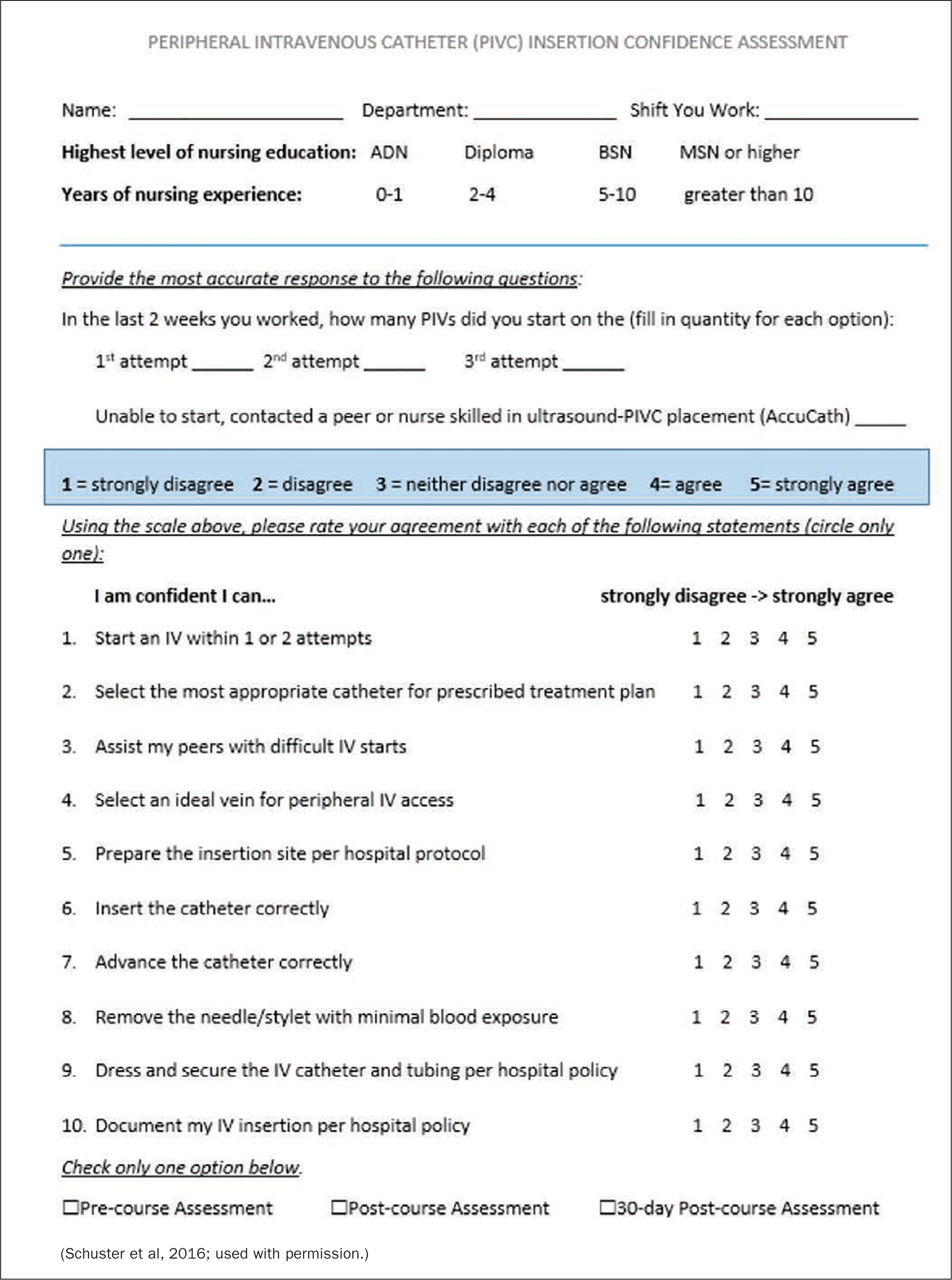
The Nursing Confidence Survey was modified from Schuster et al (2016) and included 10 areas of assessment. Nurses self-reported confidence levels using a Likert scale from 1–5 with 1 being strongly disagree and 5 being strongly agree. The results from the pre- and post-course surveys can be seen in Figure 9.
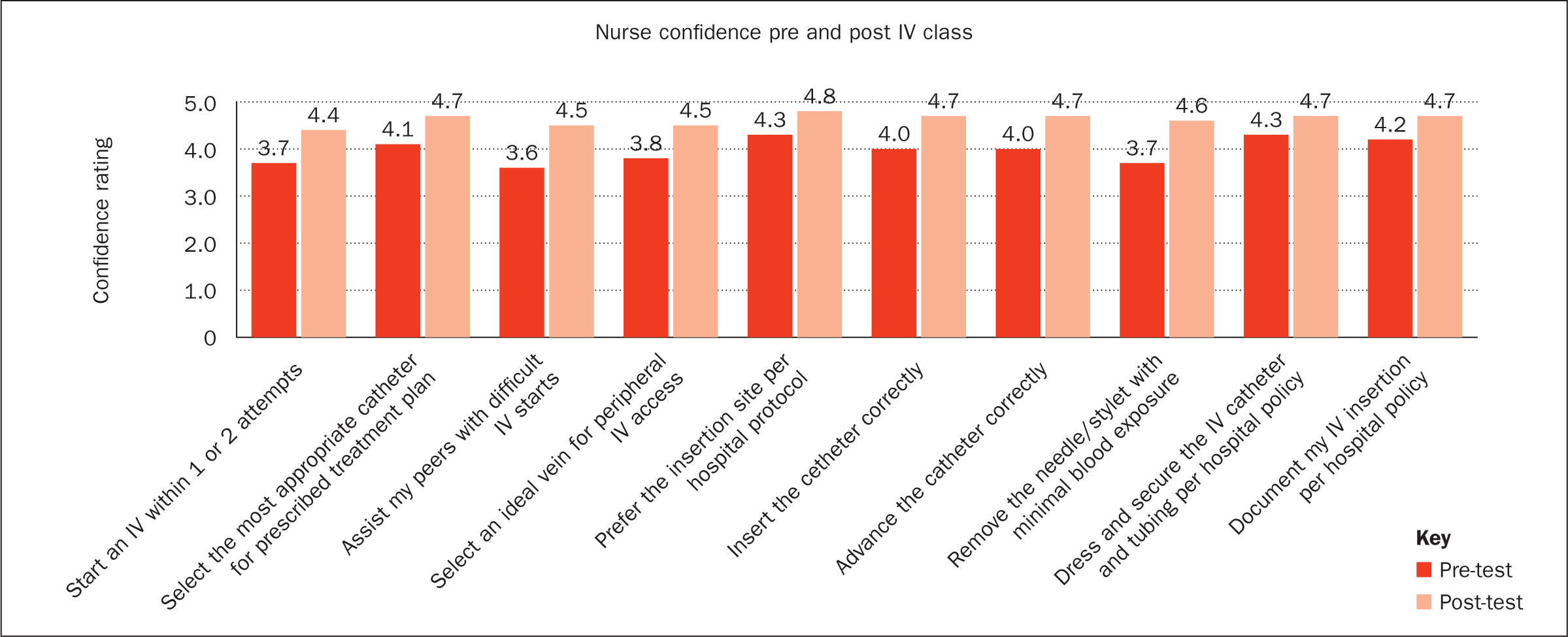
The initial results showed an increase in confidence in all 10 statements from the pre-course (baseline) to the post-course survey conducted at the conclusion of the training sessions. The confidence assessment was repeated 14 and 28 days later and those results revealed confidence further increased in six survey statements. Confidence levels of the four remaining questions were still higher than pre-course results.
The Peripheral Intravenous Champion Courses were well-received. The attendees provided such great feedback that the CNO gave approval to expand the training to all bedside nurses.
Discussion
The journey toward vascular access excellence started with the belief that the organization could improve vascular access for DIVA patients. The initial performance improvement DNP Capstone project to implement a nurse-driven protocol for the identification and management of DIVA patients and expediting the arrival of a nurse with advanced skills in VAD placement, demonstrated higher first-attempt success rates and a shorter time from the call for assistance to successful device placement (Campos, 2019). This was sustained once the program expanded hospital-wide and was verified during the vascular access assessment conducted in May 2022 in which nurses reported being able to get an advanced-skilled nurse to the bedside in under an hour over 73% of the time (Salinas Valley Memorial Hospital, 2022).
Nurses advocating for better patient care and driving their own practice, and a receptive leadership team, allowed a robust vascular access program to blossom into a level of patient care excellence beyond what was envisioned originally. Difficult intravascular access patients began requesting USGPIVCs once they experienced the benefit of ultrasound guidance. Having recognized the value of advanced-skilled nurses, additional training in USGPIVC insertion has continued, providing nurse availability across all shifts with a total of 92 nurses completing the program since inception in 2016.
Following the creation of an electronic nursing order for VAD placement on DIVA patients, requests for USGPIVCs increased and are closely aligned with the actual number of USGPIVCs placed. This indicates nurses are trained to perform patient vascular assessments properly and to escalate insertion to an advanced-skilled nurse appropriately.
Additionally, requests for the ED physicians to insert CVADs occurred less often, allowing the physicians to complete other workload activities. This has been demonstrated in other studies where USGPIVCs were inserted in the ED setting (Amick et al., 2022). There was a decrease in central line usage between 2018–2022 and a reduction in central line days by 50%, as of July 2023.
Fewer insertion attempts and longer catheter dwell times translate to fewer venipunctures and PIVC restarts, which means less pain and patient dissatisfaction commonly reported with multiple attempts (Adhikari et al, 2015; Psaila et al, 2023). Reduced costs associated with resource expenditure and fewer delays in care are commonly seen with similar programs that utilize vascular access specialists and ultrasound guidance for PIVC insertion (Adhikari et al, 2015; Amick et al, 2022; Bahl et al, 2018; Bell and Spencer, 2021). A reduction in the number of central line insertions also translates to fewer opportunities for CLABSIs or other known complications from placement of these more invasive devices.
As a result of the hospital-wide nursing education on insertion, care, and maintenance of CVADs in the Fall of 2019, a positive impact was seen with a decrease in the number of CLABSIs and non-central line-associated BSIs between 2019 and 2020, despite being in the height of the COVID-19 pandemic. The focus on standardized care in PIVC insertion continues with ongoing training expanding to all bedside nurses. As requirements transition in 2024, should the mandated reporting of all-cause BSIs be enacted, the organization is positioned to track, trend, and continue to improve care.
The increase in the number of ultrasound machines and near-infrared vein visualization devices throughout the hospital allows advanced-skilled nurses to have access to the equipment when needed. This was verified during the vascular access assessment when the nurses surveyed confirmed they had access to ultrasound machines 100% of the time. In addition, training arms are readily available for practice and precepting of new nurses.
As further evidence of the nurses' dedication and nursing leadership support, the USGPIVC training program has continued to thrive and additional training courses are being conducted. The data demonstrates the wide availability of nurses throughout the organization on all shifts able to assist with DIVA patient VAD insertions and that a generalized nurse USGPIVC insertion program can be highly effective. Opportunities to track individual nurse key performance indicators and patient outcomes have been identified and the robust reports created by the Manager of Clinical Informatics are now available to nursing leaders. The aggregate data provide valuable information and allow the nursing leaders and VAEC members to make informed decisions on which units and shifts to target in upcoming USGPIVC training cohorts and where additional resources may be needed.
The next rounds of Peripheral Intravenous Catheter Champion Courses are scheduled in August and October of 2023. As a final example of dedication to the program, additional IV training models are being purchased, including some to be housed in the clinical areas for the PIVC Champions to use for on-the-unit training as opportunities are identified.
Limitations
Several limitations exist and require additional evaluation over time to validate outcomes. The initiatives were implemented at a single public-district acute care hospital, limiting generalizability. Due to a change in the role of the critical care educator that initiated the USGPIVC program and challenges during the COVID-19 pandemic, the results of the program were not consistently tracked over time. Longitudinal data collection would be necessary to definitively capture the true outcomes of the initiatives implemented. With the reports created by Clinical Informatics, outcomes of VAD placement and individual advanced-skill nurse placement success may be easier to track. Additional opportunities exist to verify key performance indicators, such as time from referral for VAD placement to actual device insertion, and may guide future performance improvement initiatives. Finally, patient satisfaction was not formally measured and would be beneficial to evaluate as part of the ongoing vascular access excellence initiative.
Conclusion
Establishing a true vascular access excellence program requires organizations to be forward-thinking and committed to seeking innovative interventions and processes to effectively improve the quality of patient care. This organization has tackled many of the challenges of vascular access through standardized nursing assessments, training, education, and outcome monitoring, and continues to seek new ways to optimize patient outcomes.
As we move forward, additional efforts will focus on identifying causes of catheter-related bloodstream infections and implementing processes to intervene at the first sign of a potential PIVC complication through real-time analytics and EMR documentation reports. The initiative implemented in this organization standardized vascular access insertion and patient care through a collaborative multidisciplinary approach. The results of this program may be generalizable to other acute care hospitals and potentially reduce associated healthcare costs, expedite the arrival of a vascular access nurse for VAD insertion on DIVA patients, and prevent poor patient outcomes.
About the authors
Cheryl Campos, DNP, NPD-BC, CPHQ, CEN, VA-BCTM, Medical Staff Peer Review Specialist. Dr. Campos is an experienced Clinical Performance Improvement Specialist, Nursing/Physician Peer Review Specialist, and Critical Care Educator. She has been a nurse for more than 30 years, 20 of those years in the Emergency Department. Her focus is on improving patient outcomes in nurse-placed vascular access devices and doing the right thing FIRST. Dr. Campos holds certifications in Vascular Access (VA-BC), Nursing Professional Development (NPD-BC), is a Certified Professional in Healthcare Quality (CPHQ), and is Certified in Emergency Nursing (CEN). She has extensive teaching, project facilitation and implementation skills, and national and international presentation experience.
Megan Lopez, MSN, RN, CNL, VA-BC™, Diagnostic Imaging Charge Nurse, has worked in a variety of clinical areas and roles, including the Heart Center, Telemetry Resource Nurse, and Transport Nurse. She has worked in Interventional Radiology for the past six years as a charge nurse and PICC nurse. She is the Chair of the Quality Council and the Vascular Access Excellence Committee, and a member of the Evidence-Based Practice and Procedural Councils. She played a significant role in the Magnet Site Project Management leading up to the successful achievement of ANCC Magnet Recognition® for Salinas Valley Health Medical Center in 2021. In addition to her clinical experience, she has worked as an Adjunct Faculty member at Hartnell College Nursing Program. She is Certified as a Clinical Nurse Leader and Vascular Access Board Certified.
Vanessa Irwin-Nieto, DNP, RN, NPD-BC, NE-BC, CNML, CNE, CLC, is the Director of Education. She received her Associate Degree in Nursing from Hartnell College, Bachelors of Science in Nursing from California State University, San Jose, Masters of Science in Nursing from California State University, San Jose, and Doctorate of Nursing Practice from California State University, Fresno. Vanessa holds certifications in Nursing Professional Development (NPD-BC), Education (CNE), and Leadership (NE-BC & CNML).
Vanessa has worked at Salinas Valley Health for over 20 years and has experience in Pediatrics, Medical-Surgical Nursing, and Nursing Education. Vanessa is focused on the professional growth and development of nurses and serves nurses as the executive sponsor for the Professional Development Council and the Clinical Ladder Review Board.
Randy Richards, BSHI, RN, Manager of Clinical Informatics, is a Registered Nurse with Intensive Care Unit experience. He holds a Bachelor's degree in Health Informatics and is currently the Manager of the Clinical Informatics Department. He also has experience as a Regulatory Strategy Analyst and Business Intelligence developer. He is skilled at designing and deploying efficient reporting systems and dashboards to elevate strategic management and guide action plans.
Melissa R. Deen, BSN, PHN, RN, is the infection prevention manager and has more than 15 years of experience in infection prevention. Melissa is a former president and president-elect of the San Joaquin Valley APIC Chapter. She obtained her Bachelor of Science degree from the California State University, Fresno, and is currently pursuing her Master's in Public Health.
Agnes Lalata, MSN, CMSRN, CMNL, is the Clinical Nursing Director for the Medical-Surgical Departments. She holds certifications in both medical-surgical nursing and nursing leadership. She enjoys medical-surgical nursing, seeing it as a ‘potpourri’ of patients.


